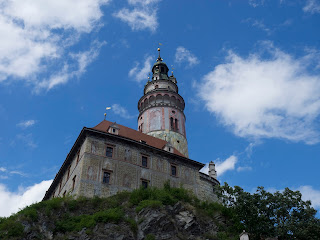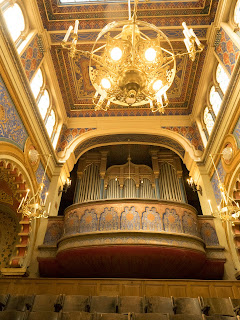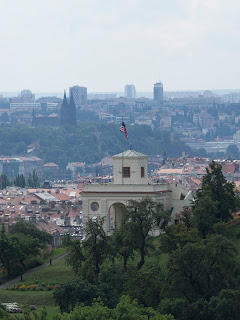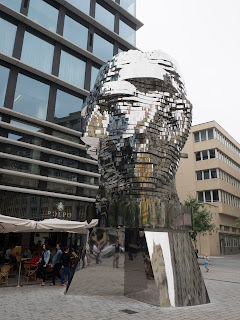Day 8:Cesny-Krumlov
(Just found out that our boat has had problems and is in dry dock! We were given the option of a refund or continue as a bus/cycling trip. Option 1 is not a real option with our luggage, i.e.. bike, so it looks like we'll be spending time on a bus:)
Oh well, 1st work problems. I'm not sure what the internet availability will be over the next few days. Last night we got stuck in a huge traffic jam (accident with helicopters, etc.) and didn't get back from Cesny Krumlov until after 8 (planned 4pm). This was to be my catch-up on the blog time. Sorry. Maybe today on the bus to Vienna. We will be on the boat in dry dock as a hotel there for 4 or 5 nights)
Construction
of the town and castle began around 1240 at
a ford in the Vltava River, an important trade route in Bohemia. It was first
mentioned in 1253 as Chrumbenowe.
According to local legend, the name derives from the German "Krumme
Aue" which can be translated as "crooked meadow".In 1302 the
town and castle were acquired by the House of Rosenberg. The majority of
inhabitants were German at that time.
The
town was not really touched during either the Czech civil war (a few hundred years ago that lasted 200
years) or WWI or WWII. This spared it
from destruction and it now looks pretty much as it did in the middle ages.
We
spent the day wandering the streets and enjoying the views from the castle
tower.
Our drive home was quite eventful. The 2-hour drive back to Prague took us well over 4 hours. We were stuck in traffic not moving for about 45 minutes. Our guide, Blanka, called her father in Prague who found out there was a huge accident that stopped traffic, until at least 7pm. So, our driver decided to reroute via back roads. It allowed us to see some beautiful Czech countryside. Finally, around 8pm, we finally got a glimpse of Prague. It made for a very long day.
We got back very late, but the weather was beautiful and wanted to see if we could get better night photos of the Prague skyline.
We had to get up early for our departure from Prague. We were in bed around 11:00 when the phone rang. Erik and Beth Roper, a very nice couple that we met from Virginia, called. At the Santana Banquet that we did not attend, Bill announced that the boat we were to be on starting tomorrow had engine problems that were catastrophic and could not be fixed in the near future, and that we would be taking a bus to Vienna tomorrow and staying on the boat at dock. We would be using it as our hotel for the next 5 nights, and then bussing to Budapest. We were in shock. The point of the trip, was to sail along the Danube and ride. Bill offered to refund our money, but rearranging the trip at this point at the height of the tourist season was unrealistic. So, other than 2 couples, the rest of us decided to make the best of it.

















































































